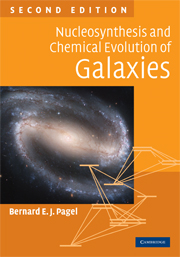Book contents
- Frontmatter
- Contents
- List of abbreviations
- Preface to the first edition
- Preface to the second edition
- 1 Introduction and overview
- 2 Thermonuclear reactions
- 3 Cosmic abundances of elements and isotopes
- 4 Cosmological nucleosynthesis and abundances of light elements
- 5 Outline of stellar structure and evolution
- 6 Neutron capture processes
- 7 Galactic chemical evolution: basic concepts and issues
- 8 Some specific GCE models and related observational data
- 9 Origin and evolution of light elements
- 10 Radioactive cosmochronology
- 11 Chemical evolution in other sorts of galaxies
- 12 Cosmic chemical evolution and diffuse background radiation
- Appendix 1 Some historical landmarks
- Appendix 2 Some physical and astronomical constants
- Appendix 3 Time-dependent perturbation theory and transition probabilities
- Appendix 4 Polytropic stellar models
- Appendix 5 Dissipation and abundance gradients
- Appendix 6 Hints for problems
- References
- Index
4 - Cosmological nucleosynthesis and abundances of light elements
Published online by Cambridge University Press: 05 June 2012
- Frontmatter
- Contents
- List of abbreviations
- Preface to the first edition
- Preface to the second edition
- 1 Introduction and overview
- 2 Thermonuclear reactions
- 3 Cosmic abundances of elements and isotopes
- 4 Cosmological nucleosynthesis and abundances of light elements
- 5 Outline of stellar structure and evolution
- 6 Neutron capture processes
- 7 Galactic chemical evolution: basic concepts and issues
- 8 Some specific GCE models and related observational data
- 9 Origin and evolution of light elements
- 10 Radioactive cosmochronology
- 11 Chemical evolution in other sorts of galaxies
- 12 Cosmic chemical evolution and diffuse background radiation
- Appendix 1 Some historical landmarks
- Appendix 2 Some physical and astronomical constants
- Appendix 3 Time-dependent perturbation theory and transition probabilities
- Appendix 4 Polytropic stellar models
- Appendix 5 Dissipation and abundance gradients
- Appendix 6 Hints for problems
- References
- Index
Summary
But the helium which we handle must have been put together at some time and some place. We do not argue with the critic who urges that the stars are not hot enough for this process; we tell him to go and find a hotter place.
A. S. Eddington, The Internal Constitution of the StarsIntroduction
The ‘Hot Big Bang’ theory of the Universe was pioneered by George Gamow, R. A. Alpher and R. C. Herman in the late 1940s and early 50s. They supposed that during the first few minutes of the (then radiation-dominated) Universe, matter was originally present in the form of neutrons and that, after some free decay, protons captured neutrons and successive captures, followed by β-decays, built up all the elements (Alpher & Herman 1950).
C. Hayashi (1950) first put the theory on a sound physical basis by pointing out that, at the high densities and temperatures involved, there would be thermal equilibrium between protons and neutrons at first, followed by a freeze-out, and this did nothing to overcome the difficulty already known to be inherent in that theory that the absence of stable nuclei at mass numbers 5 and 8 would prevent significant nucleosynthesis beyond helium. In the meantime, progress in the theory of stellar evolution and nucleosynthesis (see Chapter 5) led to comparative neglect of Big Bang nucleosynthesis theory (BBNS) until the discovery by A. A. Penzias and R. Wilson in 1964 of the microwave background radiation, existence of which Gamow and his colleagues had predicted.
- Type
- Chapter
- Information
- Nucleosynthesis and Chemical Evolution of Galaxies , pp. 119 - 151Publisher: Cambridge University PressPrint publication year: 2009

